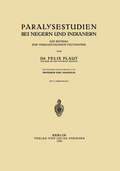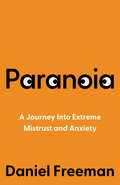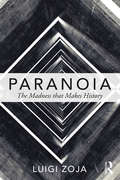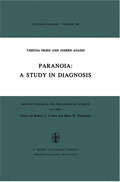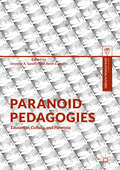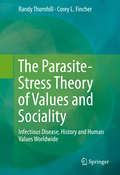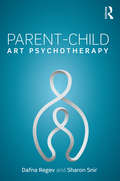- Table View
- List View
Parallel Models of Associative Memory: Updated Edition
by Geoffrey E. Hinton James A. AndersonThis update of the 1981 classic on neural networks includes new commentaries by the authors that show how the original ideas are related to subsequent developments. As researchers continue to uncover ways of applying the complex information processing abilities of neural networks, they give these models an exciting future which may well involve revolutionary developments in understanding the brain and the mind -- developments that may allow researchers to build adaptive intelligent machines. The original chapters show where the ideas came from and the new commentaries show where they are going.
Parallel Models of Associative Memory: Updated Edition
by Geoffrey E. Hinton James A. AndersonThis update of the 1981 classic on neural networks includes new commentaries by the authors that show how the original ideas are related to subsequent developments. As researchers continue to uncover ways of applying the complex information processing abilities of neural networks, they give these models an exciting future which may well involve revolutionary developments in understanding the brain and the mind -- developments that may allow researchers to build adaptive intelligent machines. The original chapters show where the ideas came from and the new commentaries show where they are going.
Paralysestudien bei Negern und Indianern: Ein Beitrag zur Vergleichenden Psychiatrie
by Felix Plaut Emil KraepelinDieser Buchtitel ist Teil des Digitalisierungsprojekts Springer Book Archives mit Publikationen, die seit den Anfängen des Verlags von 1842 erschienen sind. Der Verlag stellt mit diesem Archiv Quellen für die historische wie auch die disziplingeschichtliche Forschung zur Verfügung, die jeweils im historischen Kontext betrachtet werden müssen. Dieser Titel erschien in der Zeit vor 1945 und wird daher in seiner zeittypischen politisch-ideologischen Ausrichtung vom Verlag nicht beworben.
Paranoia: A Journey Into Extreme Mistrust And Anxiety (Maudsley Ser.)
by Daniel Freeman'A TRULY IMPORTANT BOOK’ JOHN HUMPHRYS 'FASCINATING… SHOCKING' SPECTATOR What is paranoia? What makes us mistrustful? How can this be overcome?
Paranoia: The madness that makes history
by Luigi ZojaLuigi Zoja presents an insightful analysis of the use and misuse of paranoia throughout history and in contemporary society. Zoja combines history with depth psychology, contemporary politics and tragic literature, resulting in a clear and balanced analysis presented with rare clarity. The devastating impact of paranoia on societies is explored in detail. Focusing on the contagious aspects of paranoia and its infectious, self-replicating dynamics, Zoja takes such diverse examples as Ajax and George W. Bush, Cain and the American Holocaust, Hitler, Stalin and Othello to illustrate his argument. He reconstructs the emblematic arguments that paranoia has promoted in Western history and examines how the power of the modern media and mass communication has affected how it spreads. Paranoia clearly examines how leaders lose control of their influence, how the collective unconscious acquires an autonomous life and how seductive its effects can be – more so than any political, religious or ideological discourse. This gripping study will be essential reading for depth and analytical psychologists, and academics and students of history, cultural studies, psychology, classical studies, literary studies, anthropology and sociology.
Paranoia: The madness that makes history
by Luigi ZojaLuigi Zoja presents an insightful analysis of the use and misuse of paranoia throughout history and in contemporary society. Zoja combines history with depth psychology, contemporary politics and tragic literature, resulting in a clear and balanced analysis presented with rare clarity. The devastating impact of paranoia on societies is explored in detail. Focusing on the contagious aspects of paranoia and its infectious, self-replicating dynamics, Zoja takes such diverse examples as Ajax and George W. Bush, Cain and the American Holocaust, Hitler, Stalin and Othello to illustrate his argument. He reconstructs the emblematic arguments that paranoia has promoted in Western history and examines how the power of the modern media and mass communication has affected how it spreads. Paranoia clearly examines how leaders lose control of their influence, how the collective unconscious acquires an autonomous life and how seductive its effects can be – more so than any political, religious or ideological discourse. This gripping study will be essential reading for depth and analytical psychologists, and academics and students of history, cultural studies, psychology, classical studies, literary studies, anthropology and sociology.
Paranoia: A Study in Diagnosis (Boston Studies in the Philosophy and History of Science #50)
by A. Fried J. AgassiThere is a curious parallel between the philosophy of science and psychiatric theory. The so-called demarcation question, which has exercised philosophers of science over the last decades, posed the problem of distinguishing science proper from non-science - in par ticular, from metaphysics, from pseudo-science, from the non rational or irrational, or from the untestable or the empirically meaningless. In psychiatric theory, the demarcation question appears as a problem of distinguishing the sane from the insane, the well from the mentally ill. The parallelism is interesting when the criteria for what fails to be scientific are seen to be congruent with the criteria which define those psychoses which are marked by cognitive failure. In this book Dr Yehuda Fried and Professor Joseph Agassi - a practicing psychiatrist and a philosopher of science, respectivel- focus on an extreme case of psychosis - paranoia - as an essentially intellectual disorder: that is, as one in which there is a systematic and chronic delusion which is sustained by logical means. They write: "Paranoia is an extreme case by the very fact that paranoia is by definition a quirk of the intellectual apparatus, a logical delusion. " (p. 2.
Paranoid Pedagogies: Education, Culture, and Paranoia
by Jennifer A. Sandlin Jason J. WallinThis edited book explores the under-analyzed significance and function of paranoia as a psychological habitus of the contemporary educational and social moment. The editors and contributors argue that the desire for epistemological truth beyond uncertainty characteristic of paranoia continues to profoundly shape the aesthetic texture and imaginaries of educational thought and practice. Attending to the psychoanalytic, post-psychoanalytic, and critical significance of paranoia as a mode of engaging with the world, this book further inquires into the ways in which paranoia functions to shape the social order and the material desire of subjects operating within it. Furthermore, the book aims to understand how the paranoiac imaginary endemic to contemporary educational thought manifests itself throughout the social field and what issues it makes manifest for teachers, teacher educators, and academics working toward social transformation.
Paranoid Pedagogies: Education, Culture, and Paranoia
by Jennifer A. Sandlin Jason J. WallinThis edited book explores the under-analyzed significance and function of paranoia as a psychological habitus of the contemporary educational and social moment. The editors and contributors argue that the desire for epistemological truth beyond uncertainty characteristic of paranoia continues to profoundly shape the aesthetic texture and imaginaries of educational thought and practice. Attending to the psychoanalytic, post-psychoanalytic, and critical significance of paranoia as a mode of engaging with the world, this book further inquires into the ways in which paranoia functions to shape the social order and the material desire of subjects operating within it. Furthermore, the book aims to understand how the paranoiac imaginary endemic to contemporary educational thought manifests itself throughout the social field and what issues it makes manifest for teachers, teacher educators, and academics working toward social transformation.
Paranormality: Why we see what isn't there
by Richard Wiseman'People are emotionally drawn to the supernatural. They actively want weird, spooky things to be true . . . Wiseman shows us a higher joy as he deftly skewers the paranormal charlatans, blows away the psychic fog and lets in the clear light of reason.' Richard DawkinsProfessor Richard Wiseman is clear about one thing: paranormal phenomena don't exist. But in the same way that the science of space travel transforms our everyday lives, so research into telepathy, fortune-telling and out-of-body experiences produces remarkable insights into our brains, behaviour and beliefs. Paranormality embarks on a wild ghost chase into this new science of the supernatural and is packed with activities that allow you to experience the impossible. So throw away your crystals, ditch your lucky charms and cancel your subscription to Reincarnation Weekly. It is time to discover the real secrets of the paranormal.Learn how to control your dreams -- and leave your body behindConvince complete strangers that you know all about themUnleash the power of your unconscious mind
The Paraphilias: Changing Suits in the Evolution of Sexual Interest Paradigms
by J. Paul FedoroffOf the thousands of papers and books about problematic sexual behaviors, most focus solely on sex crimes or so-called "hyper-sexuality" or "sexual addiction." Together, these publications present a grim and pessimistic prognosis for anyone who has unusual sexual interests of any type. This book challenges that view by providing a more informed and balanced review of what is known and what is not known about unconventional sexual interests. It is based on approximately thirty years of experience by the author concerning the assessment and treatment of paraphilias and unconventional sexual interests. The Paraphilias: Changing Suits in the Evolution of Sexual Interest Paradigms examines current and past perspectives concerning unconventional sexual interests associated with both criminal and non-criminal activities. Extensively referenced, it challenges the dogma that sexual interests are immutably determined during a single critical period and are thereafter unchangeable. The book provides extensive case histories and tables summarizing over 100 paraphilias and the latest research regarding them. It also reviews diagnostic criteria for the paraphilias. Analyses of current and past paradigms are presented together with new ways to understand, investigate, and provide meaningful and effective assistance to people with paraphilias. It is written for mental health clinicians and specialists in the fields of sexology and forensic psychiatry and psychology.
The Paraphilias: Changing Suits in the Evolution of Sexual Interest Paradigms
by J. Paul FedoroffOf the thousands of papers and books about problematic sexual behaviors, most focus solely on sex crimes or so-called "hyper-sexuality" or "sexual addiction." Together, these publications present a grim and pessimistic prognosis for anyone who has unusual sexual interests of any type. This book challenges that view by providing a more informed and balanced review of what is known and what is not known about unconventional sexual interests. It is based on approximately thirty years of experience by the author concerning the assessment and treatment of paraphilias and unconventional sexual interests. The Paraphilias: Changing Suits in the Evolution of Sexual Interest Paradigms examines current and past perspectives concerning unconventional sexual interests associated with both criminal and non-criminal activities. Extensively referenced, it challenges the dogma that sexual interests are immutably determined during a single critical period and are thereafter unchangeable. The book provides extensive case histories and tables summarizing over 100 paraphilias and the latest research regarding them. It also reviews diagnostic criteria for the paraphilias. Analyses of current and past paradigms are presented together with new ways to understand, investigate, and provide meaningful and effective assistance to people with paraphilias. It is written for mental health clinicians and specialists in the fields of sexology and forensic psychiatry and psychology.
Parapsychology: The Science of Unusual Experience
by David Groome Ron RobertsContaining contributions from leading paranormal researchers, this edition of Parapsychology continues to challenge and provoke readers with some of psychology’s most puzzling phenomena. Whether believers or sceptics, the book provides readers with the opportunity to further their understanding of the paranormal, bridging the gap between traditional psychology and its so-called fringe areas. Featuring updates to many of the original chapters, this book brings readers up to date with the wealth of radical research in the field. This edition also includes several new chapters, covering subjects as diverse as possession and exorcism, conspiracy theories, reincarnation, and religious belief, many of which are extremely relevant in the world today. Drawing on a range of research, the book provides a balanced introduction to parapsychology, exploring the strengths and limitations of scientific investigation itself. Parapsychology is for readers from a variety of backgrounds: professionals in the field, students, lay readers and anyone who wants to understand what the paranormal can tell us about ourselves. A variety of viewpoints are on offer, with the emphasis on the reader to make up their own mind. Prepared to be unsettled, again…
Parapsychology: The Science of Unusual Experience (A\hodder Arnold Publication)
by David Groome Ron RobertsContaining contributions from leading paranormal researchers, this edition of Parapsychology continues to challenge and provoke readers with some of psychology’s most puzzling phenomena. Whether believers or sceptics, the book provides readers with the opportunity to further their understanding of the paranormal, bridging the gap between traditional psychology and its so-called fringe areas. Featuring updates to many of the original chapters, this book brings readers up to date with the wealth of radical research in the field. This edition also includes several new chapters, covering subjects as diverse as possession and exorcism, conspiracy theories, reincarnation, and religious belief, many of which are extremely relevant in the world today. Drawing on a range of research, the book provides a balanced introduction to parapsychology, exploring the strengths and limitations of scientific investigation itself. Parapsychology is for readers from a variety of backgrounds: professionals in the field, students, lay readers and anyone who wants to understand what the paranormal can tell us about ourselves. A variety of viewpoints are on offer, with the emphasis on the reader to make up their own mind. Prepared to be unsettled, again…
Parapsychology: The Science of Unusual Experience
by David Groome Ron RobertsThis new edition of Parapsychology continues to challenge and provoke readers with some of psychology’s most puzzling phenomena. Whether believers or sceptics, the book provides readers with the opportunity to further their understanding of the paranormal, bridging the gap between traditional psychology and fringe areas.With contributions from leading paranormal researchers, this edition has been thoroughly updated and includes new chapters on dreams, precognition and prediction of future events and anthropology. The book has been reorganised to help readers frame each phenomenon within the context of cognition, science and religion, and chapters are structured around science and experience, cognition and belief, religious belief and science, and further topics in parapsychology. The book covers a range of topics that can be considered parapsychological; including reincarnation, entity encounters, astrology, mediumship and near-death experiences.Providing a balanced introduction to parapsychology that explores the strengths and limitations of scientific investigation, this is essential reading for students and professionals in the field, along with anyone interested in learning more about the science of the paranormal.
Parapsychology: The Science of Unusual Experience
This new edition of Parapsychology continues to challenge and provoke readers with some of psychology’s most puzzling phenomena. Whether believers or sceptics, the book provides readers with the opportunity to further their understanding of the paranormal, bridging the gap between traditional psychology and fringe areas.With contributions from leading paranormal researchers, this edition has been thoroughly updated and includes new chapters on dreams, precognition and prediction of future events and anthropology. The book has been reorganised to help readers frame each phenomenon within the context of cognition, science and religion, and chapters are structured around science and experience, cognition and belief, religious belief and science, and further topics in parapsychology. The book covers a range of topics that can be considered parapsychological; including reincarnation, entity encounters, astrology, mediumship and near-death experiences.Providing a balanced introduction to parapsychology that explores the strengths and limitations of scientific investigation, this is essential reading for students and professionals in the field, along with anyone interested in learning more about the science of the paranormal.
The Parasite-Stress Theory of Values and Sociality: Infectious Disease, History and Human Values Worldwide
by Randy Thornhill Corey L. FincherThis book develops and tests an ecological and evolutionary theory of the causes of human values—the core beliefs that guide people’s cognition and behavior—and their variation across time and space around the world. We call this theory the parasite-stress theory of values or the parasite-stress theory of sociality. The evidence we present in our book indicates that both a wide span of human affairs and major aspects of human cultural diversity can be understood in light of variable parasite (infectious disease) stress and the range of value systems evoked by variable parasite stress. The same evidence supports the hypothesis that people have psychological adaptations that function to adopt values dependent upon local infectious-disease adversity. The authors have identified key variables, variation in infectious disease adversity and in the core values it evokes, for understanding these topics and in novel and encompassing ways. Although the human species is the focus in the book, evidence presented in the book shows that the parasite-stress theory of sociality informs other topics in ecology and evolutionary biology such as variable family organization and speciation processes and biological diversity in general in non-human animals.
Parasites, Pussycats and Psychosis: The Unknown Dangers of Human Toxoplasmosis
by E. Fuller TorreyThis open access book analyzes the evidence linking Toxoplasma gondii to the increasing incidence of schizophrenia and bipolar disorder in the United States. Initially establishing that infectious agents are regularly transmitted from animals to humans, lead to human disease, and that infectious agents can cause psychosis, it then examines the protozoan parasite Toxoplasma gondii in detail. Infecting 40 million Americans, Toxoplasma gondii is known to cause congenital infections, eye disease, and encephalitis for individuals who are immunosuppressed. It has also been shown to change the behavior of nonhuman mammals, as well as to alter some personality traits in humans. After discussing the clinical evidence linking Toxoplasma gondii to human psychosis, the book elucidates the epidemiological evidence further supporting this linkage; including the proportional increase in incidence of human psychosis as cats transitioned to domestication over 800 years. Finally, the book assesses the magnitude of the problem and suggests solutions.Parasites, Pussycats and Psychosis: The Unknown Dangers of Human Toxoplasmosis provides a comprehensive review of the evidence linking human psychosis in the United States to infections of Toxoplasma gondii. It will be of interest to infectious disease specialists, general practitioners, scientists, historians, and cat-lovers.
Parasocial Experiences: Psychological Theory and Application
by David C. Giles Gayle S. SteverThis book covers key aspects of parasocial relationships (PSRs), or the relationships people have with media personalities, including fictional characters. The principal feature of a PSR is that it is not individually reciprocated although when the parasocial object is a real person, usually a celebrity, that celebrity often has a reciprocal relationship with their audience as a group. The authors begin by addressing the many instances where relationships exist in a gray area that is neither fully social and reciprocated nor parasocial and non-reciprocated. In describing parasocial experience, the authors address social relationships vs. parasocial relationships as a continuum rather than a dichotomy. They also discuss prominent theories in psychology and how they should be applied to parasocial theory, as well as psychoanalytic theory and the role of the unconscious in parasocial relationships. This is followed by chapters on applications of evolutionary psychology, attachment theory, and the effects of social media on PSRs, particularly a very new social media service, Cameo. Through a meaningful exploration of social theories as they influence parasocial experiences, this book unveils areas for future study and opens up pathways for new, more sophisticated research.
Parasocial Experiences: Psychological Theory and Application
by David C. Giles Gayle S. SteverThis book covers key aspects of parasocial relationships (PSRs), or the relationships people have with media personalities, including fictional characters. The principal feature of a PSR is that it is not individually reciprocated although when the parasocial object is a real person, usually a celebrity, that celebrity often has a reciprocal relationship with their audience as a group. The authors begin by addressing the many instances where relationships exist in a gray area that is neither fully social and reciprocated nor parasocial and non-reciprocated. In describing parasocial experience, the authors address social relationships vs. parasocial relationships as a continuum rather than a dichotomy. They also discuss prominent theories in psychology and how they should be applied to parasocial theory, as well as psychoanalytic theory and the role of the unconscious in parasocial relationships. This is followed by chapters on applications of evolutionary psychology, attachment theory, and the effects of social media on PSRs, particularly a very new social media service, Cameo. Through a meaningful exploration of social theories as they influence parasocial experiences, this book unveils areas for future study and opens up pathways for new, more sophisticated research.
Parasomnias: Clinical Characteristics and Treatment
by Sanjeev V. Kothare and Anna IvanenkoParasomnias are phenomena that occur exclusively during sleep or are exacerbated during sleep/wake transition. These disorders are known to contribute towards impaired quality of life, disturbed and non-restorative sleep, risk for injuries to self and others and often associated with other medical, neurological and psychiatric disorders. Advances in sleep medicine have revealed a high prevalence of parasomnias across all ages. With the growing interest for diagnosing and management of parasomnias in sleep medicine, a practical guide to parasomnias is greatly needed.Parasomnias provides a comprehensive review of epidemiology, pathophysiology, clinical characteristics, diagnostic evaluation and treatment of parasomnias across the patient’s life span. Written by experts, each chapter integrates the latest research and clinical data. In addition, several chapters address medico-legal and forensic aspects of parasomnias.Clinicians and researchers with an interest in sleep medicine will find Parasomnias to not only be an important contribution to the literature, but an indispensible guide to identifying, understanding and treating this disorder.
Paraverbal Communication with Children: Not through Words Alone
by E.P. Heimlich A.J. MarkFor over twenty years I have been privileged to observe, partic ipate in, and contribute to the development of the ideas and techniques that culminated in this most unusual, impressive, and useful book. in words the total experience While it is difficult to convey of this innovative therapeutic approach, this volume enables the reader to become a part of these therapy sessions and to learn to "know" and appreciate these fruitful methods. The techniques described in detail in this volume are designed for use with children who are viewed as "resi stant" and uncommunicative-a fairly large percentage of youth who have not responded to traditional therapy. The approach is based on many practical assumptions. Among them are the idea that rhythm, of whatever nature, cannot be "shut out"; that one can have pleasure in producing c- v vi FOREWORD munication (fun of all things); and that pleasure and accep tance lead to the integration of motility, emotions, and ideation. These all lead to increased self-esteem and compe tence. The selection of the modality is completely individu alized and leads to a therapy with the child-not to or at the child. To complete the circle, the method is eminently teachable. Thus, both students in training and practicing therapists who are concerned with promoting growth and development in the children they treat will find this guide exceptionally use ful and stimulating. H. D. Dunton, M. D.
Parent-Child Art Psychotherapy
by Dafna Regev Sharon SnirParent-Child Art Psychotherapy presents a working model of ways to incorporate parents into a child’s art therapy sessions, drawing on the relational-psychoanalytic notion of mentalization in the treatment of difficulties within childhood relationships. The model is introduced by clearly explaining the theory, the setting, the role of the therapist, and the work with the parents. In addition, the book offers a full section dedicated to practical applications of the model, replete with illustrative case studies and detailed therapeutic art-based interventions covering leadership, movement, collaborative and solitary work, and parent-child exercises. Intended for art therapists, students, parent-child psychotherapists, and other therapists interested in expanding their knowledge in the field, Regev and Snir provide a definition and conceptualization of a short-term treatment model with the potential to have comprehensive effects leading to positive change.

